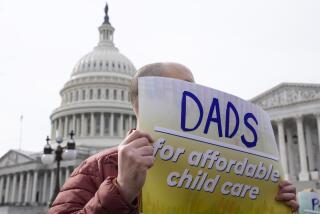Op-Ed: Will having kids soon be out of reach economically for many American families?
Parenthood should be affordable in this country, but the cost of raising a child from birth to adulthood is now a quarter of a million dollars and projected to double by the time todayâs toddlers reach their teens. Will having kids soon be out of reach economically for many American families?
A recent report from the Center for American Progress found that middle-class families are feeling an unprecedented economic squeeze â caught between stagnating wages and the exploding cost of basics like housing, healthcare and childrenâs education. Most families, it seems, are getting by on less and living closer to the financial edge to help their kids grow up healthy and get ahead.
The most striking growth in costs to families has been in child care, where expenses have climbed about $200 annually in each of the last dozen years, with nearly tenfold growth since the 1960s. Child care, on average, consumes $1 of every $5 in a familyâs budget and exceeds the typical rent in every state.
In terms of their kidsâ health, families increasingly have to choose between treating their childrenâs medical needs and paying household bills. Despite gains in the percentage of children with health insurance, per capita medical spending on kids has quietly ballooned faster than for any other age group, with families paying more for premiums and steeper out-of-pocket expenses.
For evidence to suggest that middle-class parents might already be getting priced out of parenthood, look to the national birthrate. It fell sharply in the recession but, unlike in previous economic rebounds, has continued to drop. This makes sense in financial context, given that most families havenât seen their incomes grow since the recovery began and the median net worth of households has actually fallen below what it was 15 years ago. Most families today donât have enough saved to meet basic needs for three months, let alone save for college or retirement.
For folks in the middle class, the economic calculus of raising kids must be daunting. Not only are the costs unaffordable, but parents also face a harsh ultimatum: âKeep up with the Gatesesâ or risk your childrenâs health, achievement and long-term well-being.
Higher-income families spend six times more than working-class families on child care and educational resources, such as high-quality day care, summer camps, computers and private schools, which are increasingly indispensable investments in long-term success. This spending inequity has tripled over the last four decades and is only accelerating, which is likely to widen the achievement gap, creating a vicious cycle.
The public education infrastructure, designed generations ago to drive a strong economy and give every child an equal footing for success, is crumbling from neglect â stuck between those who argue for repair and those who argue for redesign. As a consequence, it is unable to prepare most kids for the new economy. The statistics are grim: Two-thirds of preschoolers donât have access to high-quality child care, two-thirds of public school students fail to meet math and language proficiency by eighth grade, and two-thirds of public high schoolers arenât ready for college when they graduate.
To solve these problems we have increasingly relied on a public safety net designed to catch what used to be a small number of kids falling through the cracks. But over the last 50 years those cracks have become chasms. When funding constraints force programs such as Early Head Start to enroll just 4% of eligible children needing early intervention and half of pediatricians opt out of accepting kids on Medicaid, these are clear signs that itâs time to rethink our approach.
These economic realities are contributing to a swift loss of academic opportunity, health prospects and upward mobility among children whose parents cannot afford to spend top dollar. With this de facto economic segregation of opportunity leaving working families in the economic dust, we are risking the prosperity and social mobility of our kids for years to come.
We should be reinvesting in working families and modernizing our public infrastructure. Not only would this make parenthood more feasible, it also makes good economic sense. We know that investing early in kids yields considerable savings by reducing chronic health problems, building stable families and increasing earning potential.
The opportunity to raise healthy, smart and successful kids shouldnât be an economic luxury. Itâs time we made parenthood affordable again by investing more in kids and families. Given that whatâs at stake is the success of our country, the alternative is unaffordable.
Adam Schickedanz, a pediatrician, is a clinical scholar and researcher in the departments of pediatrics and general internal medicine and health services research at UCLA. Neal Halfon, a pediatrician, is director of the UCLA Center for Healthier Children, Families and Communities.
Follow the Opinion section on Twitter @latimesopinion
More to Read
Sign up for Essential California
The most important California stories and recommendations in your inbox every morning.
You may occasionally receive promotional content from the Los Angeles Times.










